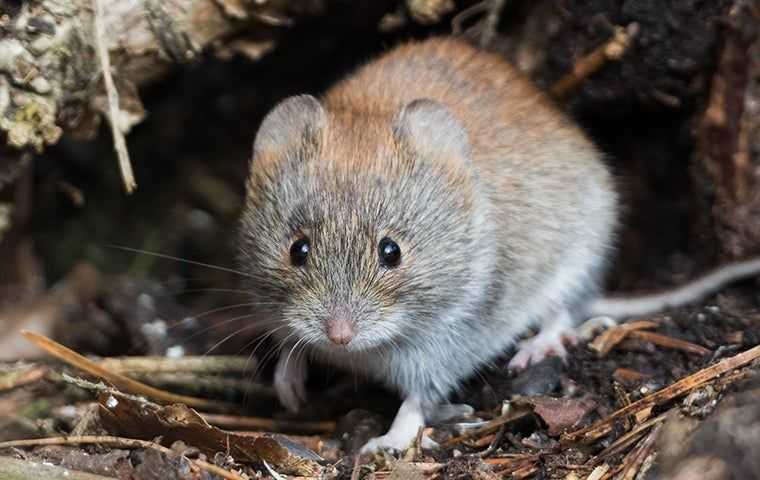
Don't Let Voles Tear Up Your Garden
If there's one thing that can drive a homeowner or frequent gardener insane, it's voles in Los Angeles County! These tiny rodents will make small tunnels throughout your lawn if left uncontrolled. So how can you prevent them from tearing up your yard and garden?
Here's what Los Angeles County homeowners should know about what voles look like, how they get into your yard, signs of a vole problem in your garden, and how to keep them away permanently with pest control in Los Angeles County.
How To Keep Voles Away For Good!
Because voles reproduce so quickly, it's important to get a handle on a vole infestation before it spirals out of control and destroys both your garden and yard. Fortunately, you can take action against these pests by enlisting the help of HomeShield Pest Control's vole control service.
If you're seeing any of the signs listed above or have other reasons to believe you might have voles, don't wait any longer – contact us today at HomeShield Pest Control to learn more about how we can help you keep voles away permanently.

What Does A Vole In Los Angeles County Look Like?
You may see evidence of their destruction, but not all homeowners know what voles look like. These rodents can be easy to miss, and they're often mixed up with moles, another animal that enjoys tunneling through yards and gardens.
Voles have round bodies with short tails, small, beady eyes, and rounded ears that aren't always visible through their reddish-brown fur. While moles tend to have long noses and look like they have no eyes, a vole's eyes are always visible, and their noses aren't as prominent.
Some other key facts you should know about voles include:
- You may also hear voles referred to as meadow mice due to their mouse-like appearance.
- Including their tails, voles can grow anywhere from four to nine inches long.
- Voles are mostly herbivores that feed on plants, which is why they're so fond of gardens.
- Voles are some of the fastest reproducers in the rodent family, and a single female vole can produce anywhere from thirty to sixty young per year.
- Voles build underground tunnels in gardens and yards for both shelter and protection, and may occasionally use the burrowing holes that other animals have made.
Voles are usually not aggressive, but they can still be bad news for your Los Angeles County garden.
How Do You Get Voles In Your Yard?
Now you know what voles look like, but how did these rodents get in your yard in the first place? There are a couple of different factors that can attract voles to your property, including:
- Long or tall grass: Voles like yards and lawns that provide them with a lot of coverage when they come out of their burrows. Yards with tall, un-mowed grass may be more attractive to these rodents.
- Yard debris: Much like tall grass, yard debris and clutter can provide voles with even more hiding spots on your property.
- Gardens with no fencing: Voles like easy access, and gardens that don't have fencing provide voles with an even more accessible food source. Even with fencing, voles may still be able to get to your garden if the fence doesn't go very far into the ground.
- Large gardens: No surprise, voles like a plentiful food source, so they may spend more time in yards that have bigger gardens and more plants for them to feed on.
- Yards with a water source: Yards that have decorative ponds or another water source that’s easy for voles to access are likely to be more attractive to these pests.
While you can't control for every variable, keeping your yard and garden well-maintained and fenced in can go a long way towards minimizing the risk of voles moving in.
Signs Of Voles In Your Garden
There are plenty of things that may attract voles to your property, but they live primarily underground, so how do you know they are there? Here are some major signs that can indicate a vole problem in your garden:
- There are tiny holes near the base of trees in your yard, which are vole burrows.
- There are paths one to two inches wide on the surface of your lawn.
- There are places in your yard where the grass is very short, despite not cutting it.
- There are chew marks near the bottom of plants and young trees.
- The exposed stem on certain plants have been chewed into a pointed end.
- When you lift up dead plants, there's no remaining root structure in the ground.
All of these signs can indicate that you've got voles in your garden feeding on your plants and trees.

Our California Pest Control Services
In California, We Provide Reliable Home Pest Control And Commercial Pest Control Solutions.
Why Our Customers Love Us
HomeShield Pest Control received an average rating of 5.0 out of 5 stars from over 8000+ reviews.
-
Homeshield was great to work with!“Homeshield was great to work with! My wife and I encountered a really bad termite problem at our new home during the renovation phase, and needed treatment asap so that renovation could resume. Mike drove all the way down for an inspection, and was very thorough in his explanations. He was able to match a competitor's price for the treatment and locked in a day for the following week. Daniel and Elias, the technicians, were very communicative about their ETA and did a good job explaining their respective roles. All in all, a quick and easy process. Thank you, Homeshield!”- James Y.
-
Pleasant, friendly and respectful.“Bronson announced his arrival and departure. He inquired if there was anything specific that we wanted done prior to him starting his regular service. Pleasant, friendly and respectful.”- Joseph S.
-
Will continue using homeshield!“
Amazing work! Switched from Terminex as I was tired of having scheduling issues and wanted something eco friendly for my dogs and upcoming baby.
”
I definitely recommend trying to get Jose Garcia as your technician as he was very communicative and kept us updated throughout the service process.
Will continue using homeshield!- Chris P.M. -
Humble and helpful. Does what ever we are asking for.“You guys provide very quality service. We are very happy with the service. Every time the person comes to our place to provide service is very humble and helpful. Does what ever we are asking for. Thank you.”- Arif S.
-
Excellent experience. Super professional and thorough“
Excellent experience. Super professional and thorough. Found them through yelp and they called immediately with affordable options and set up an appointment. The technician was wonderful. Would highly recommend.
”- Samantha S. -
Quote came within minutes and price was very reasonable.“
Dee provided a very thorough and detailed inspection. Walked us through the entire process and what we could expect throughout the initial services and beyond. Quote came within minutes and price was very reasonable.
”- Jason D. -
Ben was FANTASTIC“
Ben was FANTASTIC in every way, He came to give me an estimate on my home, was on time, polite, knowledgeable, and extremely professional in how he handled everything. Had 4 other termite co. to give me an estimate, not even close to Ben's expertise, I would give him a 10 if I could. Will definitely use him in all my other projects , they are a lot since I am in real estate and have many clients.
”- Judy M. -
Victor, was very professional, helpful and informative.“
We had a great experience. They were able to work with our schedule to make a quick appointment. The service professional, Victor, was very professional, helpful and informative.
”- Mark S.

Featured On








.svg.2405150737550.png)




